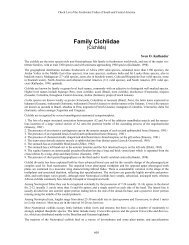Open Access PDF - Sven Kullander
Open Access PDF - Sven Kullander
Open Access PDF - Sven Kullander
You also want an ePaper? Increase the reach of your titles
YUMPU automatically turns print PDFs into web optimized ePapers that Google loves.
386<br />
Discussion<br />
Species diversity. Despite being one of the most<br />
colourful, well-known, and most commercial of<br />
the genera of cichlids, of importance to artisanal<br />
as well as tourism based sport fishing, and among<br />
the largest fishes in the Neotropics, the taxonomic<br />
confusion in Cichla has remained considerable.<br />
A major source of confusion has been the<br />
obvious acceptance in species of Cichla of much<br />
more than modest variability in colour pattern,<br />
both ontogenetic and between individuals, as well<br />
as a traditional recognition of just a few species.<br />
This has been possible because most authors have<br />
only dealt with very few specimens or a restricted<br />
geographical region. In this paper, covering a<br />
wider geographic area, we have been able to<br />
organise phenotypic variation within the genus<br />
into spatially clustered units representing 15<br />
distinct phylogenetic species.<br />
The species diversity of Cichla is thus demonstrated<br />
to be much greater than indicated by<br />
current literature. Nevertheless, we believe the<br />
work on a revision of Cichla has just started. Our<br />
species accounts include references to samples<br />
that cannot be satisfactorily assigned, and some<br />
species are still known only from a few specimens.<br />
Huge areas within the geographical range of the<br />
genus have not been sampled for fishes. We expect<br />
that there may likely exist between 20 and 30<br />
species of Cichla, which require large series of<br />
specimens and more extensive sampling to be<br />
located and diagnosed. Hopefully, this revision<br />
can inspire more efforts in further revising the<br />
genus.<br />
Morphometric and meristic variation. Scale and<br />
fin counts are moderately efficient in separating<br />
species, and are summarised in Tables 2-10. The<br />
lateral scale counts (Table 2) span from 67 to 128,<br />
comparable only to Crenicichla and Teleocichla<br />
among other Neotropical cichlid genera. Intraspecific<br />
ranges varies from 8 to 32, apparently correlated<br />
both with sample size and maximum scale<br />
number. Large-scaled species, C. ocellaris, C. orinocensis,<br />
C. nigromaculata, C. monoculus, C. kelberi,<br />
C. pleiozona, C. melaniae, C. melaniae, and C. thyrorus<br />
generally possess less than 90 E1 scales,<br />
whereas remaining, small-scaled species, generally<br />
possess more than 90 scales (C. piquiti and<br />
C. pinima down to 83 and 86 respectively). The<br />
overlap is considerable in the genus as a whole,<br />
and there are no instances of normal distribution.<br />
The slender species tend to have more scales.<br />
Three potential low frequency counts occur in the<br />
distribution (Table 2, Fig. 4), potentially distinguishing<br />
classes of scale counts. The first at 81<br />
scales (3 specimens) separates C. ocellaris, C. monoculus<br />
and C. mirianae as having lower scale<br />
counts. At 88 scales (2 specimens) C. orinocensis,<br />
C. nigromaculata, C. kelberi, C. melaniae, and C. thyrorus<br />
are separated from the small-scaled species<br />
C. piquiti, C. jariina, C. pinima, C. vazzoleri, and<br />
C. intermedia, and at about 110 scales (3 specimens)<br />
C. temensis separates from the rest. With this interpretation,<br />
only C. kelberi significantly spans<br />
over the drop at 88 scales. Alternatively, a drop<br />
at 92-93 scales (3 specimens each) separates largescaled<br />
and small-scaled species, with two species<br />
transcending, C. piquiti and C. pinima.<br />
Cichla is occasionally diagnosed as having a<br />
continuous lateral line as young, frequently becoming<br />
discontinuous in the adult (Eigenmann,<br />
1912; Newsome, 1971; Stiassny, 1982, Webb, 1990)<br />
in contrast with most cichlids, which have a<br />
dorsal anterior lateral line section and a midaxial<br />
posterior section at all sizes. However, a continuous<br />
lateral line (Table 3) occurs frequently (61-<br />
85 % of the specimens) only in four species, viz.<br />
C. ocellaris, C. thyrorus, C. temensis, and C. intermedia.<br />
The condition is exceptional (4-7 %) in<br />
C. orinocensis, C. pleiozona, and C. piquiti, and infrequent<br />
in C. pinima (36 %) and C. vazzoleri (15 %).<br />
Three of six specimens of C. jariina possess continuous<br />
lateral line. As with the E1 scale counts,<br />
there is no normal distribution and ranges overlap<br />
for lateral line scale counts, with small-scaled<br />
species tending to have more lateral line scales.<br />
Discontinuous lateral line occurs in all species<br />
of Cichla. Counts of scales in the upper lateral line<br />
(Table 4) vary similar to scale counts in the E1<br />
row and continuous lateral line. The number of<br />
scales in the lower lateral line (Table 5) is more<br />
restricted, with C. temensis, C. vazzoleri, C. pinima,<br />
and C. piquiti having slightly higher numbers than<br />
the rest, but also greater variation. The overlap<br />
between species is almost complete. There is no<br />
indication of an ontogenetic transition from continuous<br />
to discontinuous state in any of the species.<br />
The early development of the lateral line<br />
tubes is bidirectional (cf. Webb, 1990), with caudad<br />
succession in the anterior (upper) sequence<br />
and rostrad succession in the posterior (lower)<br />
sequence. Some of the variation in species usually<br />
possessing a continuous lateral line, observed<br />
<strong>Kullander</strong> & Ferreira: Review of Cichla




